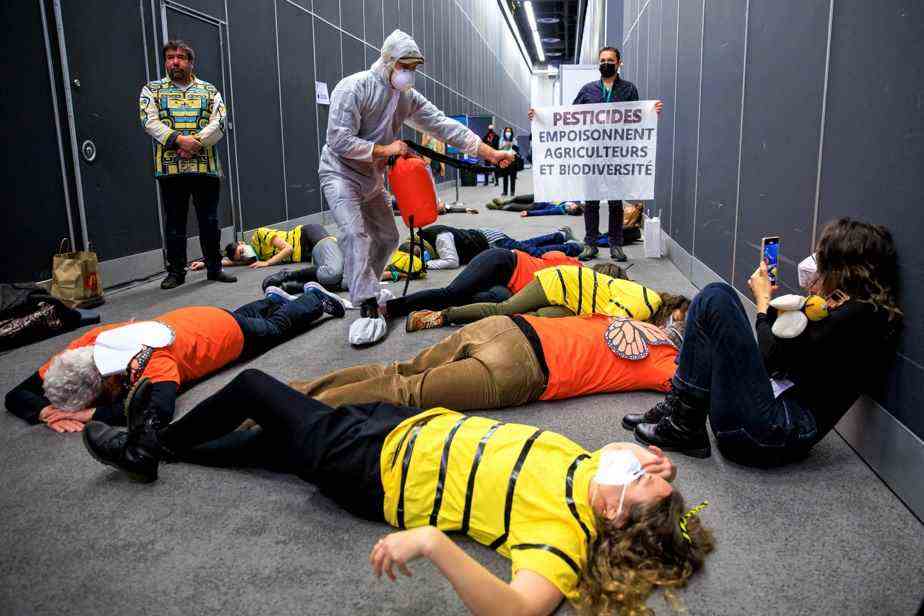The presence of CropLife — a powerful lobby representing the pesticide industry — at COP15 is disturbing environmental groups. While the 196 member countries of the Convention on Biological Diversity are debating a proposal to reduce the use of pesticides on the planet by two thirds, environmentalists staged a coup on Thursday to express their concern.
Dressed as bees and monarch butterflies, the activists collapsed to the ground in a hallway at the Palais des Congrès in Montreal leading to a room that hosted a panel organized by CropLife International.
“Why were they accredited?” asked Charlotte Dawn of the Wilderness Committee group. “And that’s especially when there are well-meaning participants who are desperate to take action and have the space in those rooms to do so. Instead, they are occupied by multinationals that seek the status quo and have been given a voice for too long. »
Agriculture is at the heart of the discussions at the international summit on biodiversity. Target 7, which addresses the issue of reducing pollution, proposes to halve or two-thirds the use of pesticides by 2030. If the text is approved, it would be the first global reduction target pesticides.
“CropLife has no place in such events. Clearly, they should be excluded,” lamented Thibault Rehn, coordinator of Vigilance OGM. “They curb the ambition of the delegates. We have countries that want an ambitious pesticide reduction target and they are there to undermine that target. »

PHOTO ALAIN ROBERGE, THE PRESS
Thibault Rehn
When they see a two-thirds pesticide reduction target, they see a two-thirds reduction in their profits.
Thibault Rehn, coordinator of Vigilance OGM
“I am disgusted,” added the hereditary chief of the Kwakiulth nation in British Columbia, David Mungo Knox. “I am quite upset with their presence here today because they are part of the devastation [de l’environnement]. »
CropLife against the 2/3 target
CropLife is an association that represents companies that market seeds and pest control products. Its members include agrochemical giants like Monsanto-Bayer, Corteva, Syngenta-ChemChina and SynAgri. She also represents the Quebec company Sollio Agriculture.
During the panel, a representative from the David Suzuki Foundation stepped up to the microphone to ask the CropLife representatives if they supported Target 7 and its two-thirds reduction goal.
“We support the very ambitious pollution reduction target, but we don’t support the obtuse pesticide reduction target,” responded Christoph Neumann, CropLife International’s vice president of crop protection regulatory policy.
“Infeasible”
In interview with The Press after the panel, he added that “pollution reduction” should be managed at the local level.
“The use of pesticides varies greatly from country to country. The United States, Canada and the European Union have very high rates of agricultural yields, they also have a high rate of pesticide use. In sub-Saharan Africa, it’s rather low: they use a quarter compared to the rest of the planet. This is why the OECD and the Food and Agriculture Organization (FAO) came to the conclusion in 2021 that in reality agriculture should be intensified and that access to pesticides was compulsory for food safety. »

PHOTO ALAIN ROBERGE, THE PRESS
Christoph Neumann of CropLife International
Is the two-thirds reduction target possible within seven years? “In my opinion, it doesn’t make sense,” he replied, pointing out that the abrupt (and temporary) shift to 100% organic farming in Sri Lanka in 2021 has taken its toll.
“It would be devastating first and foremost for countries. If you look at what happened in Sri Lanka, two thirds, 70% is not far from that. I think it’s infeasible. As with everything, there needs to be a transition. »
The President and CEO of CropLife Canada agrees with his colleague.
“The application of pesticides is not pollution as such because it has an effect where you target, where you aim in a field. If the pesticide ends up in water or in fields where it has no effect, we call it drift or point pollution,” explained Pierre Petelle on the sidelines of the conference.
The latter says that CropLife supports mitigation measures such as riparian strips or agricultural equipment that allows products to be applied more precisely.
“The main goal is to reduce the drift of pesticides which are not the areas that do their job. »
